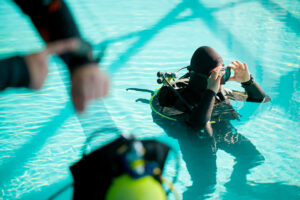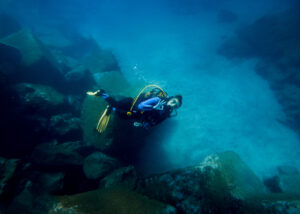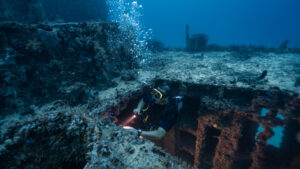What is a Surface Marker Buoy?
A Surface Marker Buoy (SMB), also known as a safety sausage or dive sausage, is a critical safety device used by scuba divers to indicate their location to people at the surface. Their usage is widespread in recreational and professional diving, as they provide an essential visual reference for boat operators, dive masters, and rescue teams.
Historical Context and Design
The origins of the Surface Marker Buoy can be traced back to the early years of scuba diving. As diving grew popular, the need for divers to communicate their location while underwater became increasingly apparent. Divers would often surface far from their starting point due to currents or navigation errors, which posed a risk of becoming lost or colliding with boats.
The design of the SMB is simple yet effective. Made of durable, brightly colored materials like nylon or PVC, it is designed to be highly visible even in rough sea conditions. It typically takes the form of a long, inflatable tube, often colored in vivid orange, red, or yellow. Some designs include reflective strips or flags for added visibility. The SMB is inflated via a one-way valve, either by the diver’s exhaled air or from a small, dedicated canister of compressed air.
Deployment and Usage
The deployment of the SMB requires a degree of skill. The diver typically inflates the SMB at depth, securing it to a line or reel that is released as the diver ascends. The buoy floats to the surface, indicating the diver’s location. In some cases, divers may also deploy the SMB from the surface before descending, particularly during drift dives.
An SMB is not only a safety device but also a communication tool. Specific positioning or movements can communicate different messages. For example, an SMB bobbing in the water might indicate a diver in distress, while an SMB moving steadily in one direction might signify that the dive is proceeding as planned.
Types of SMBs
There are two main types of SMBs: the standard Surface Marker Buoy and the Delayed Surface Marker Buoy (DSMB). A standard SMB is usually deployed at the start of the dive and floats on the surface as the dive progresses. It is generally attached to the diver or the dive site by a line.
The DSMB, on the other hand, is deployed while the diver is still submerged and is generally used towards the end of the dive. The “delayed” part of the name refers to the fact that the buoy remains deflated and secured to the diver until it is needed. When ready, the diver inflates the DSMB and sends it to the surface on a reel of line. This method allows boat crews or shore-based observers to track a diver’s ascent and location without the diver needing to surface.
SMBs in Different Diving Environments
In different diving environments, the use of SMBs varies. For instance, in high-traffic areas or when drift diving, an SMB is crucial for indicating the diver’s location to boats, reducing the risk of a collision. During deep dives or decompression stops, a DSMB helps to signal the diver’s position and ascent progress to surface support.
Safety Considerations
While SMBs are a key safety tool, their improper use can lead to hazards. If a diver fails to secure the SMB correctly, it can cause an uncontrolled ascent, which can lead to decompression sickness or barotrauma. It is also crucial to ensure the SMB is fully deflated before descent to avoid drag or entanglement. As such, training and practice in SMB use are essential parts of scuba diving education.
Innovation and Future Developments
With advancements in technology, the humble SMB has seen innovations that increase its utility and safety. Some SMBs now come equipped with emergency location beacons, strobe lights, or even radio transmitters that can send a GPS location to nearby boats or emergency services. These features offer an extra layer of safety, particularly in challenging or remote dive locations.
Looking towards the future, it’s likely that SMBs will continue to evolve, incorporating new technologies and materials. Despite these advancements, the basic principle of the SMB will remain the same: to serve as a lifeline between the diver and the surface, ensuring the diver’s location is known, and their progress is monitored.
Training and Best Practices
Scuba diving training organizations worldwide emphasize the importance of SMB usage in their courses. Beginner divers are often introduced to SMBs during their initial open water courses, and further training is provided in advanced and specialty courses.
Best practices for SMB usage include:
- Regular inspection and maintenance: Like all dive equipment, SMBs should be checked for wear and tear regularly and maintained properly.
- Practice in controlled environments: Before deploying an SMB in open water, divers should practice in controlled environments like swimming pools or calm, shallow water.
- Be aware of surroundings: When deploying an SMB, divers should be mindful of their surroundings to avoid entangling the SMB line with themselves, their dive buddies, or the marine environment.
The Role of SMBs in Dive Planning
In dive planning, considering the role of SMBs is crucial. Divers must decide whether to use a standard SMB or a DSMB based on the dive’s nature and the conditions they expect to encounter. They must also plan for how to communicate with their dive buddy or surface support using the SMB, establishing a shared understanding of different signals before the dive.
In conclusion, the Surface Marker Buoy is much more than a simple buoy towed by a diver. It is a lifesaver, a communicator, a beacon in the vast ocean. As diving technology advances, so too does the humble SMB, continuing to protect and guide divers as they explore the underwater world.
Key Takeaways
In summary, the Surface Marker Buoy is an essential piece of safety equipment for scuba divers. Its primary function is to indicate the diver’s location to people at
the surface, but it also serves as a vital communication tool in certain circumstances. Despite its simplicity, proper deployment and use of an SMB require skill and understanding. This highlights the broader ethos of scuba diving: even as we enjoy and explore the underwater world, safety and communication must always be paramount.

















